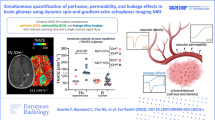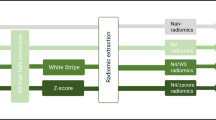Abstract
The purpose of the study was to determine the value of a logistic regression model nomogram based on conventional magnetic resonance imaging (MRI) features and apparent diffusion coefficient (ADC) histogram parameters in differentiating atypical meningioma (AtM) from anaplastic meningioma (AnM). Clinical and imaging data of 34 AtM and 21 AnM diagnosed by histopathology were retrospectively analyzed. The whole tumor delineation along the tumor edge on ADC images and ADC histogram parameters were automatically generated and comparisons between the two groups using the independent samples t test or Mann–Whitney U test. Univariate and multivariate logistic regression analyses were used to construct the nomogram of the AtM and AnM prediction model, and the model’s predictive efficacy was evaluated using calibration and decision curves. Significant differences in the mean, enhancement, perc.01%, and edema were noted between the AtM and AnM groups (P < 0.05). Age, sex, location, necrosis, shape, max-D, variance, skewness, kurtosis, perc.10%, perc.50%, perc.90%, and perc.99% exhibited no significant differences (P > 0.05). The mean and enhancement were independent risk factors for distinguishing AtM from AnM. The area under the curve, accuracy, sensitivity, specificity, positive predictive value, and negative predictive value of the nomogram were 0.871 (0.753–0.946), 80.0%, 81.0%, 79.4%, 70.8%, and 87.1%, respectively. The calibration curve demonstrated that the model’s probability to predict AtM and AnM was in favorable agreement with the actual probability, and the decision curve revealed that the prediction model possessed satisfactory clinical availability. A logistic regression model nomogram based on conventional MRI features and ADC histogram parameters is potentially useful as an auxiliary tool for the preoperative differential diagnosis of AtM and AnM.






Similar content being viewed by others
Data availability
This is not applicable.
References
Ostrom QT, Cioffi G, Waite K et al (2021) CBTRUS statistical report: primary brain and other central nervous system tumors diagnosed in the United States in 2014–2018. Neuro Oncol 23(12 Suppl 2):iii1–iii105
Apra C, Peyre M, Kalamarides M (2018) Current treatment options for meningioma. Expert Rev Neurother 18(3):241–249
Zhu H, Bi WL, Aizer A et al (2019) Efficacy of adjuvant radiotherapy for atypical and anaplastic meningioma. Cancer Med 8(1):13–20
Chen XY, Chen JY, Huang YX et al (2021) Establishment and validation of an integrated model to predict postoperative recurrence in patients with atypical meningioma. Front Oncol 11:754937
Liu X, Wang Y, Wei J et al (2022) Role of diffusion-weighted imaging in differentiating angiomatous meningioma from atypical meningioma. Clin Neurol Neurosurg 221:107406
Han T, Zhang J, Liu X et al (2022) Differentiating atypical meningioma from anaplastic meningioma using diffusion weighted imaging. Clin Imaging 82:237–243
Maggio I, Franceschi E, Tosoni A et al (2021) Meningioma: not always a benign tumor A review of advances in the treatment of meningiomas. CNS Oncology. 10(2):Cns72
Wilson TA, Huang L, Ramanathan D et al (2020) Review of atypical and anaplastic meningiomas: classification, molecular biology, and management. Front Oncol 10:565582
Goldbrunner R, Minniti G, Preusser M et al (2016) EANO guidelines for the diagnosis and treatment of meningiomas. Lancet Oncol 17(9):e383–e391
Yu H, Wen X, Wu P et al (2019) Can amide proton transfer-weighted imaging differentiate tumor grade and predict Ki-67 proliferation status of meningioma? Eur Radiol 29(10):5298–5306
Nagano H, Sakai K, Tazoe J et al (2019) Whole-tumor histogram analysis of DWI and QSI for differentiating between meningioma and schwannoma: a pilot study. Jpn J Radiol 37(10):694–700
Bohara M, Nakajo M, Kamimura K et al (2020) Histological grade of meningioma: prediction by intravoxel incoherent motion histogram parameters. Acad Radiol 27(3):342–353
Liu X, Han T, Wang Y et al (2023) Differentiating angiomatous meningioma from atypical meningioma using histogram analysis of apparent diffusion coefficient maps. Quant Imaging Med Surg 13(7):4160–4170
Wang G, Zhou J (2023) The value of whole-volume apparent diffusion coefficient histogram analysis in preoperatively distinguishing intracranial solitary fibrous tumor and transitional meningioma. Front Oncol 13:1155162
Kurokawa R, Baba A, Kurokawa M et al (2022) Pretreatment ADC histogram analysis as a prognostic imaging biomarker for patients with recurrent glioblastoma treated with bevacizumab: a systematic review and meta-analysis. Am J Neuroradiol 43(2):202–206
Magill ST, Young JS, Chae R et al (2018) Relationship between tumor location, size, and WHO grade in meningioma. Neurosurg Focus 44(4):E4
Shin HK, Park JH, Cho YH et al (2021) Risk factors for high-grade meningioma in brain and spine: systematic review and meta-analysis. World Neurosurg 151:e718–e730
Garzon-Muvdi T, Yang W, Lim M et al (2017) Atypical and anaplastic meningioma: outcomes in a population based study. J Neurooncol 133(2):321–330
Zhang H, Rodiger LA, Shen T et al (2008) Preoperative subtyping of meningiomas by perfusion MR imaging. Neuroradiology 50(10):835–840
Kawahara Y, Nakada M, Hayashi Y et al (2012) Prediction of high-grade meningioma by preoperative MRI assessment. J Neurooncol 108(1):147–152
Surov A, Meyer HJ, Wienke A (2017) Associations between apparent diffusion coefficient (ADC) and KI 67 in different tumors: a meta-analysis. Part 1: ADC(mean). Oncotarget. 8(43):75434
Xiaoai K, Qing Z, Lei H et al (2020) Differentiating microcystic meningioma from atypical meningioma using diffusion-weighted imaging. Neuroradiology 62(5):601–607
Cao T, Jiang R, Zheng L et al (2023) T1 and ADC histogram parameters may be an in vivo biomarker for predicting the grade, subtype, and proliferative activity of meningioma. Eur Radiol 33(1):258–269
Surov A, Hamerla G, Meyer HJ et al (2018) Whole lesion histogram analysis of meningiomas derived from ADC values. Correlation with several cellularity parameters, proliferation index KI 67, nucleic content, and membrane permeability. Magn Reson Imaging 51:158–62
Maynard J, Okuchi S, Wastling S et al (2020) World Health Organization Grade II/III glioma molecular status: prediction by MRI morphologic features and apparent diffusion coefficient. Radiology 296(1):111e21
Gihr GA, Horvath-Rizea D, Garnov N et al (2018) Diffusion profifiling via a histogram approach distinguishes low-grade from high-grade meningiomas, can reflect the respective proliferative potential and progesterone receptor status. Mol Imaging Biol 20(4):632e40
Liu X, Huang X, Han T et al (2022) Discrimination between microcystic meningioma and atypical meningioma using whole-lesion apparent diffusion coefficient histogram analysis. Clin Radiol 77(11):864–869
Li X, Miao Y, Han L et al (2019) Meningioma grading using conventional MRI histogram analysis based on 3D tumor measurement. Eur J Radiol 110:45–53
Schob S, Meyer HJ, Dieckow J et al (2017) Histogram Analysis of Diffusion Weighted Imaging at 3T is Useful for Prediction of Lymphatic Metastatic Spread, Proliferative Activity, and Cellularity in Thyroid Cancer. Int J Mol Sci 18(4):821
de Perrot T, Lenoir V, Domingo Ayllón M et al (2017) Apparent diffusion coefficient histograms of human papillomavirus-positive and human papillomavirus-negative head and neck squamous cell carcinoma: assessment of tumor heterogeneity and comparison with histopathology. AJNR Am J Neuroradiol 38(11):2153–2160
Surov A, Ginat DT, Lim T et al (2018) Histogram analysis parameters apparent diffusion coefficient for distinguishing high and low-grade meningiomas: a multicenter study. Transl Oncol 11(5):1074–1079
Zhang G, Zhang J, Cao Y et al (2021) Nomogram based on preoperative CT imaging predicts the EGFR mutation status in lung adenocarcinoma. Transl Oncol 14(1):100954
Funding
This study was supported by grants of the National Natural Science Foundation of China (No. 82071872, 82371914), Lanzhou University Second Hospital Second Hospital “Cuiying Technology Innovation Plan” Applied Basic Research Project (No. CY2018-QN09), Science and Technology Program of Gansu Province (21YF5FA123, 21JR11RA105), China International Medical Foundation (Z-2014–07-2101), and Medical Innovation and Development Project of Lanzhou University.
Author information
Authors and Affiliations
Contributions
Guarantor of integrity of the entire study: Tao Han and Junlin Zhou, MD, PhD. Study concepts and design: Tao Han and Junlin Zhou, MD, PhD. Literature research: Changyou Long and Xianwang Liu. Clinical studies: Changyou Long and Yuting Zhang. Experimental studies/data analysis: Yuting Zhang and Xianwang Liu. Statistical analysis: Bin Zhang and Liangna Deng. Manuscript preparation: Tao Han and Mengyuan Jing. Manuscript editing: Tao Han and Junlin Zhou, MD, PhD.
Corresponding author
Ethics declarations
Ethical approval
This study was approved by the Medical Ethics Committee of the Second Hospital of Lanzhou University (approval number: 2020A-109), and informed consent was waived.
Competing interests
The authors declare no competing interests.
Additional information
Publisher's Note
Springer Nature remains neutral with regard to jurisdictional claims in published maps and institutional affiliations.
Rights and permissions
Springer Nature or its licensor (e.g. a society or other partner) holds exclusive rights to this article under a publishing agreement with the author(s) or other rightsholder(s); author self-archiving of the accepted manuscript version of this article is solely governed by the terms of such publishing agreement and applicable law.
About this article
Cite this article
Han, T., Long, C., Liu, X. et al. Differential diagnosis of atypical and anaplastic meningiomas based on conventional MRI features and ADC histogram parameters using a logistic regression model nomogram. Neurosurg Rev 46, 245 (2023). https://doi.org/10.1007/s10143-023-02155-5
Received:
Revised:
Accepted:
Published:
DOI: https://doi.org/10.1007/s10143-023-02155-5




